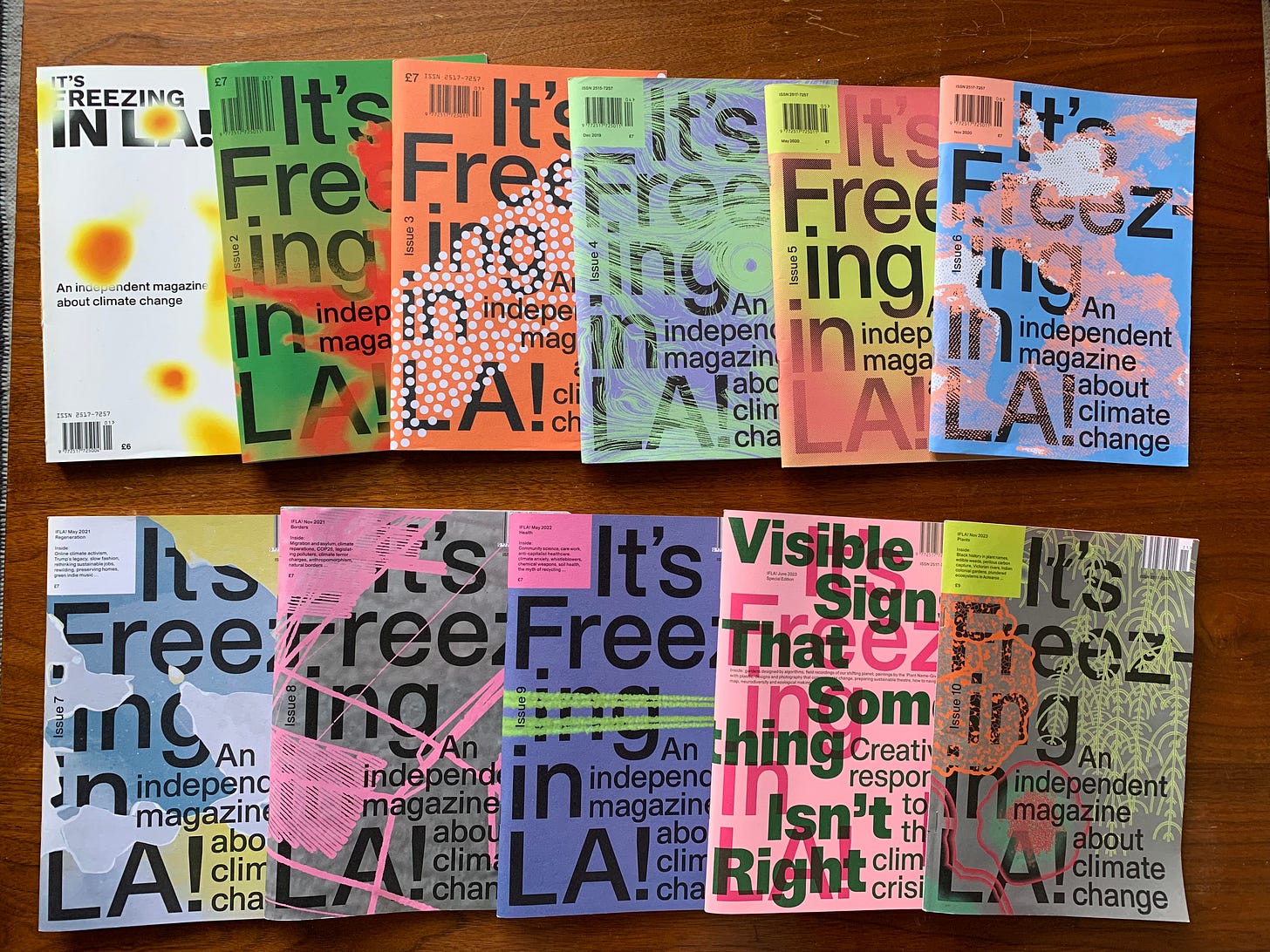Goodbye It's Freezing in LA!
My final edition of IFLA! is now out, a look at some of my favourite moments in past issues.
At the start of 2018, I was an unhappy Engineering PhD student. My thesis was on soil mechanics, which felt very distant from the challenges in the world around me (indeed, it transpired that my Masters research into offshore wind turbine foundations had been linked to Oil & Gas industry funding, since oil rig foundations faced similar design challenges - no doubt they knew few students would sign up under a more honest headline). Pre-XR and Greta, the options for effective, politically-aligned climate action felt limited, particularly in a small university town. Most of my friends were in another city, and I was struggling after a bereavement.
I quickly left the PhD - I think I did a total of 3 months, including the time my encouraging supervisor gave me to think about rewriting the brief. In the strange period that followed, I started It’s Freezing in LA!.
I was seeking a place to feel purposeful and to find a community. But I mainly wanted a space to have more serious conversations about climate. In 2018, it felt to me like my fellow climate-people were all earnest fellow engineers who could talk climate but avoided politics. I knew lots of earnest politics students but they seemed to talk about everything but. There felt like few avenues to hash out the overlap. The only way I knew how to try was go on protests (not much detailed conversation) or, kind of, make magazines - I’d been the editor of my uni science magazine.
I reached out to Nina Carter to join as Art Editor; we’d been at primary school together and ‘reconnected’ through Facebook when we’d done a call out for illustrators for the science magazine. She brought in Matthew Lewis, our designer. Alice Attlee joined to support with the text editing and gave me a much-needed push to improve the diversity of contributors and bite in the content of the first articles.
Much has changed since. In 2019, just as our 3rd issue went to print, XR arrived, and the face of climate crisis and climate activism completely changed (‘climate change’ being on the cover, rather than ‘emergency’ or ‘crisis’ is definitely a hangover from pre-2019 language). Suddenly we had readers, writers and a topic around which there was actual momentum. Our team has changed: Alice left after the first issue and Jackson Howarth became Deputy Editor - he and Nina are now taking over from me as co-Editors. Steph Glover, Hiren Parmar and Shaista Hussain all joined over time, and we had wonderful stints with Gina Castellheim, Sophie Compton and Joycelyn Longdon running events. Grace Richardson Banks ran our social media (and generally provided energy, ideas and morale) for several years. Throughout it all we've had a truly brilliant cast of editors helping Jackson and I with the articles and commissioning, many of whom were friends who humoured me when we were trying to get the first issue into the world and then supportively continued to help. And, my hope for the project became more specific, seeking to amplify the emerging and sharpening left wing ideas around climate that the 2019 renewal of attention to the topic brought, and which my own career and attentions increasingly turned to.
I never planned to be an editor, and have left mainly because I know that to be a good one requires a focus and dedication to shaping new media that is not my interest. But I am so proud of this project. It has brought me stability, peace and community, and I hope that it has contributed its own small ripples into the climate movement. I’m so thankful to the many, many people who have given us and me so much time and support. Their names are at the bottom - it has truly been a privilege.
Looking back, some highlights

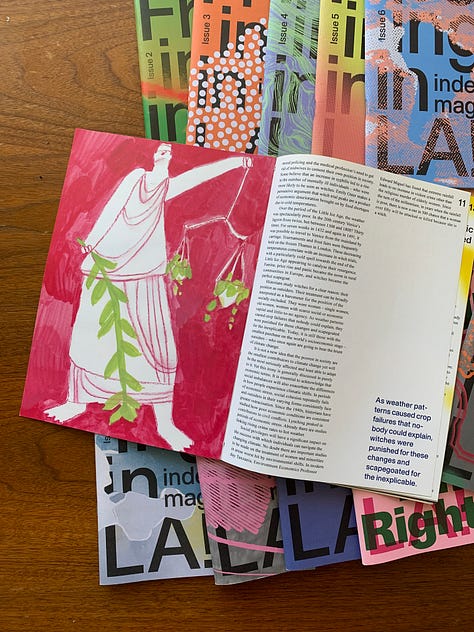
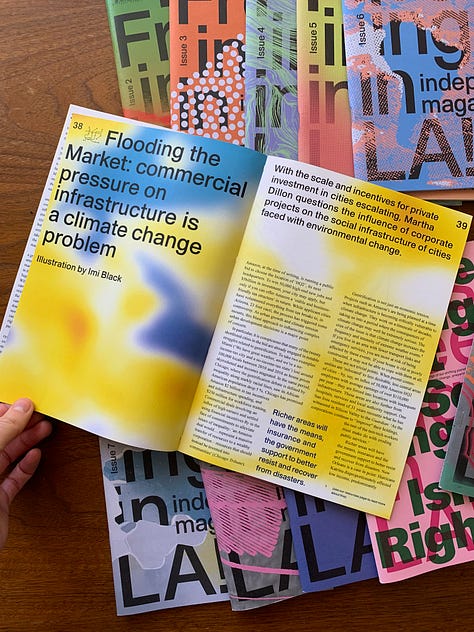
We hand-bound the first issue to ‘save money’ - a huge waste of time (it would have cost us about £50 to get the printer to staple it) but we were learning, and now it’s very special and the magazine-heads love that it lies flat. We got the spreads printed flat, trimmed off the margins in the London Graphic Centre and spent hours sitting in my dad’s kitchen pressing and sewing them up. My brother put in a mammoth shift helping, thanks Joe.
We printed 200, maybe 250 copies only. Everyone did it for free, and when printed we sent copies to magazine shops and distributors and got enough pre-orders of issue 2 to keep going. These issues are hard to find now, I only have one copy.
This was our first time working with our friends at The Sustainable Print and learning about recycled papers and non-toxic inks.
Matthew’s graphics in this issue are NASA temperature maps, the pages get redder as you read the magazine.



IFLA 2 - getting more radical - Jan 2019 A cover redesign, £1 increase in cover price and staple binding. People still calling it a zine in the pub stopped bothering me because we were feeling happy with it now!
Some of my favourite illustrations of all IFLAs are in this one - above Mary Herbert and Sammi Lynch. We were starting to find our feet and rhythm, the articles are a bit more focussed.
It contains an article by Caroline Lucas, probably one of the most well-known of people who have written for us. This came about thanks to Chris Venables, who was at the Green Party at the time and now heads policy at the Green Alliance. His help was a huge boost for us as I think it helped us persuade Stack to order 3,000 copies for their subscribers (which in turn got us on our feet with a cash injection). Thanks Chris, and Stack!
Matthew’s graphics are taken from smoke patterns from Californian wildfires.
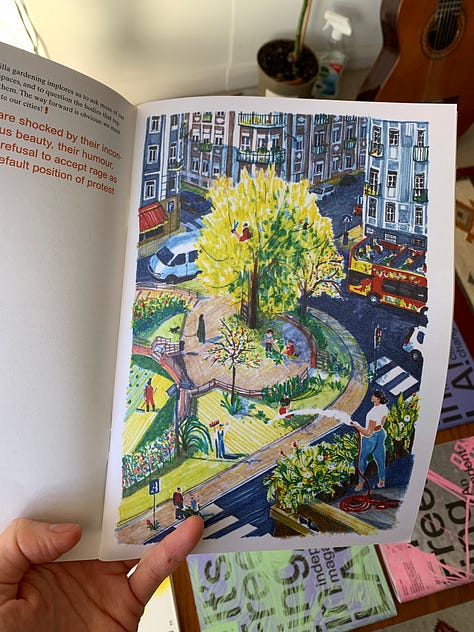

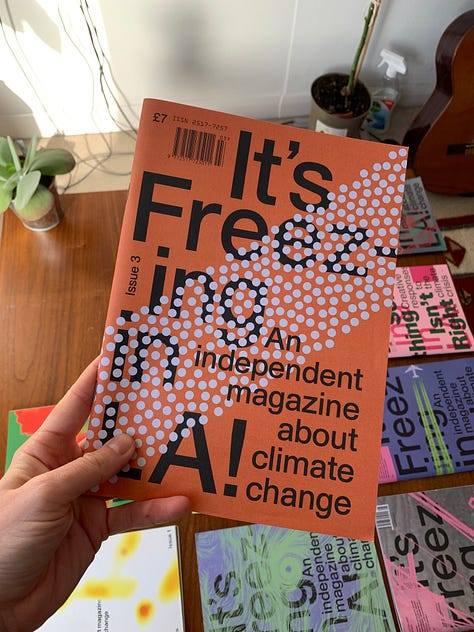
IFLA 3 - protest, more storytelling and movement-builders - May 2019 Getting into our stride with issue 3, including one of my all-time favourite pieces: on guerrilla gardening, by my friend Alexander Harris with illustration by Giulia Corascello. When we released this on audiobook, read by Bill Milner, it had an amazing response.
More people from across the wider climate movement and outside our friends and peers were starting to contribute at this stage, including people whose work I really admire and follow religiously today - Katie Kedward and Lizzie Lomax being two examples (and ft illustrations by Carbon Brief’s own Josh Gabbatiss!)
Matthew’s graphics map School Strike numbers around the world. We were publishing around the same time as XR, Greta and Fridays For Future took off, hence the theme.
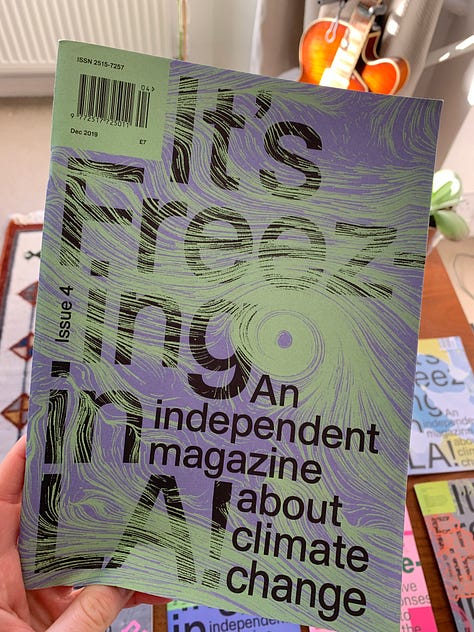

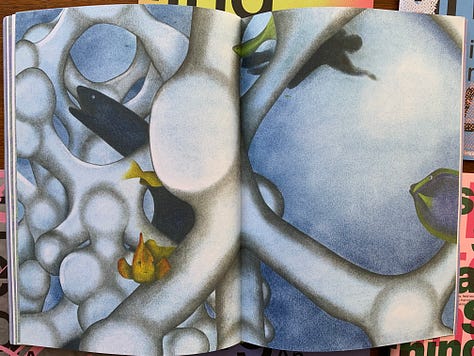
‘Post’ XR, this was an issue looking at how things might actually start to be changing. I’m not sure we realised this was the theme at the time but it feels forward-looking when reading it now.
More of my favourite illustrations are in this one (above Nina’s amazing 3D-printed coral reef double spread), and some interesting articles: an interview with Olafur Eliasson by long-time IFLA writer Kitty Grady, and we were starting to get contributions by climate journalists thanks to the early version of the London Climate Drinks network - two lovely pieces in this one by Diego Arguedas Ortiz and Jocelyn Timperley, in particular.
This issue was sponsored by Octopus Energy, as they were starting to take over as the big Green energy company. We made a spread on some quite cool ideas about community energy that I sadly don’t think they have really done much with. Maybe I’m wrong.
Matthew’s graphics here were spiralling hurricane maps… I think we had copyright drama about this but I can’t quite remember.



We have so many copies of this issue left: it was after having a big success with issue 4 so we printed loads, then COVID hit and all the shops shut. I think we still have about 1000 in storage… if anyone wants a copy let me know.
It was also a bit lost in terms of content, some lovely things in there but a bit of a strange mix! To me its strength is that we had really improved in terms of international contributors by issue 4 and 5. This one has our first piece in translation (Remembering the Timok, by Miroslava Kojadinović, who sadly passed away shortly after publication, translated by her son Miodrag).
Some of my other favourite things in it are Billie Manning’s poem Apples, the first article for us by Zainab Mahmood, who went on to join our editorial team and is now making waves in the slow fashion world, as well as Aaron Bradshaw’s brilliant piece about synthetic vs natural bacteria. Jackson and I always got very excited when there were good science pieces!
Graphics here show the ozone layer healing, mapped by Harry Lloyd and rendered by Matthew.
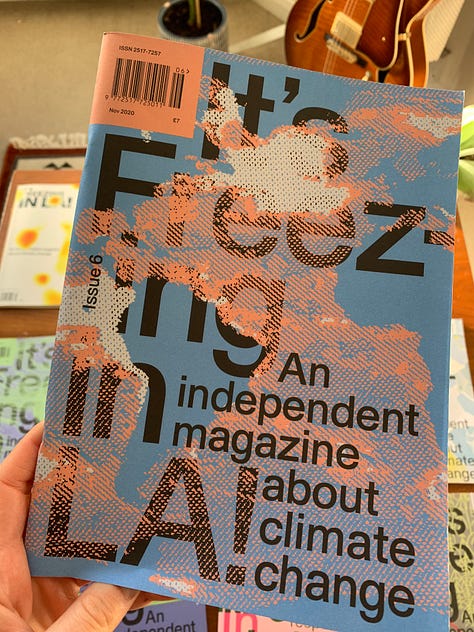


I think this issue was where I really felt we had something to say: it’s the first with a strong theme, ‘Greenwashing’. This helped us focus the writing and the curation better, and the pitches we got were also stronger as a result (we always got/get hundreds of pitches each issue, I think 6 was the first open call that became really unmanageable).
Some favourites here are Inkcap Journal founder Sophie Yeo’s piece on shifting baseline syndrome, Guardian writer Christine Ochefu’s piece on I May Destroy You and Blackness and the eco movement, and artist Alice Bucknell’s excellent deconstruction of Silicon Valley’s futuristic, climate-destroying architecture.
Matthew’s graphics here were coral reef bleaching patterns around the world. My Editor’s letter talked about how ‘greenwashing’ was a term first used by Jay Westervelt to describe the phenomenon of hotels claiming they were green (‘pick up your towels’) while building along fragile coastlines.
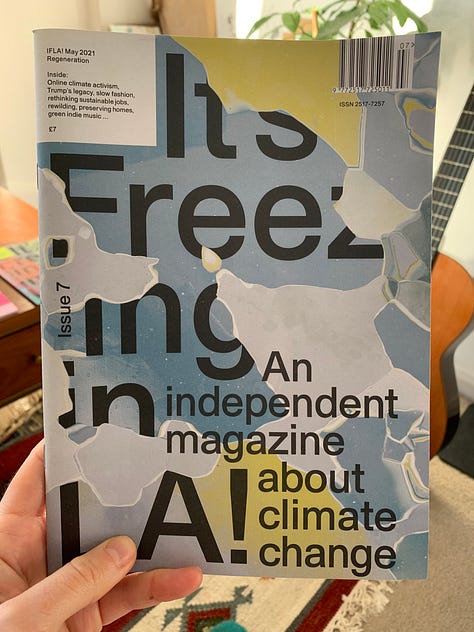
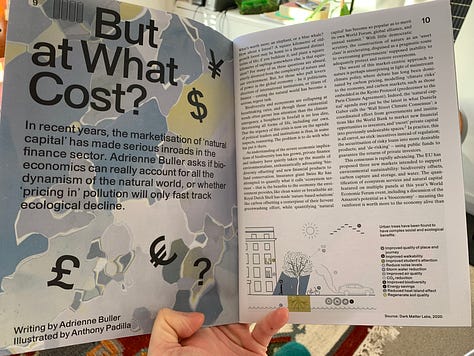
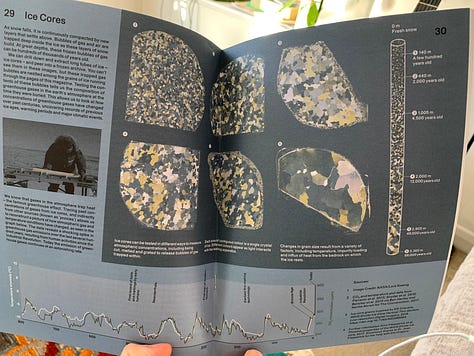
No strict theme for this one, but IFLA 7 is still a favourite, perhaps just because of the fitting icey graphics. These showed ice cores tracking historic emissions (Matthew developed these with a climate scientist, Dr Joan Fitzpatrick).
I think it just has some great articles: Adrienne Buller on the idiocy of schemes to ‘price in’ climate breakdown (the next year she wrote a full book on this which I highly, highly recommend); Molly Lipson on digital activism (she was given a book contract off this article!); and Josh Fenton from Afterparti on the anti-demolition movement and built environment activism space that is my non-IFLA day job.
I think it has our first colourful photos, a big design step!
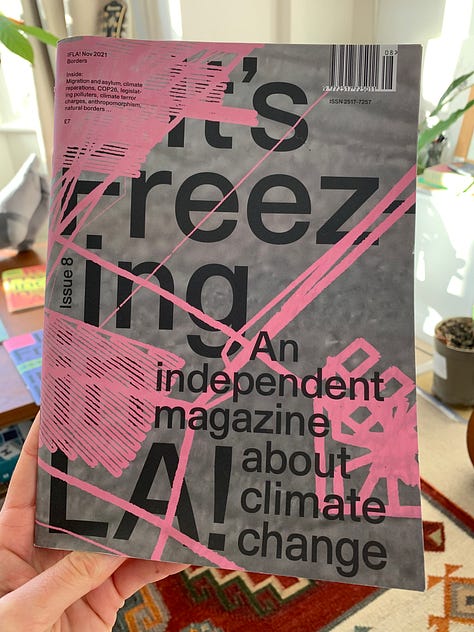
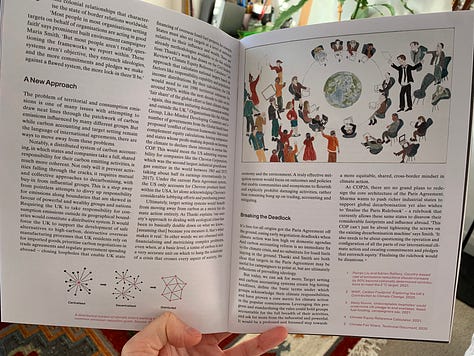

IFLA 8 was about borders, and as with ‘greenwashing’ the theme helped it focus. It’s a nice issue: to the point and Jackson and I were being more precise with the messaging and ideas.
It has Jackson’s first ‘Deputy Editor’s Letter’, I wrote about carbon accounting and targets (on my substack here) and we had Ciara Quilty-Harper doing an amazing graphic novel responding to Gail Tasker’s review of Mdou Moctar’s Afrique Victime album.
Matthew’s graphics show the areas that have been mapped of the sea floor - mostly for oil and gas exploration, and most of which the data itself is privately held, despite being open ocean. Slightly abstract but I think this actually still has legs as a relatively unexplored (excuse the pun) topic.

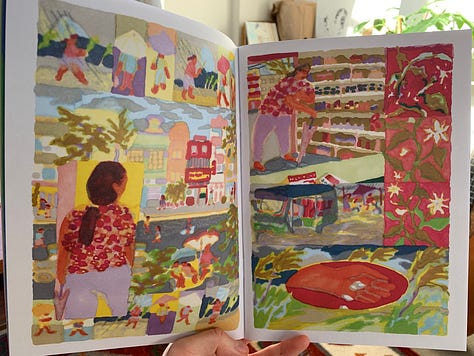
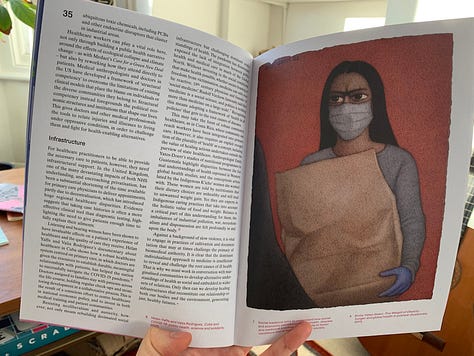
IFLA 9 is the sharpest and best edited IFLA, in my view. We had five articles sponsored by the Wellcome Collection for their digital space, and a good fee for our time on it. This gave us breathing space and direction.
I love the resulting mix of well-known and emerging writers: Owen Hatherley, Aja Barber and Imani Jacqueline Brown from Forensic Architecture next to students and testimonies by people being affected by climate (the opening article is by Manila Pharmacist Jean Ong, talking about how the people she sees are already needing new medications and facing new threats). It also contains the first write up of ideas from Abi Deivanayagam and Rhiannon Osbourne about anti-capitalist health care. They are now setting the medical world alight and getting articles in proper publications.
Matthew’s graphics here are different ‘plumes’ of pollution.
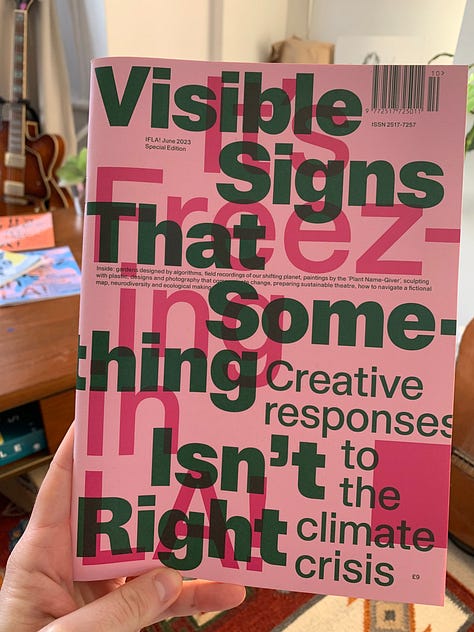
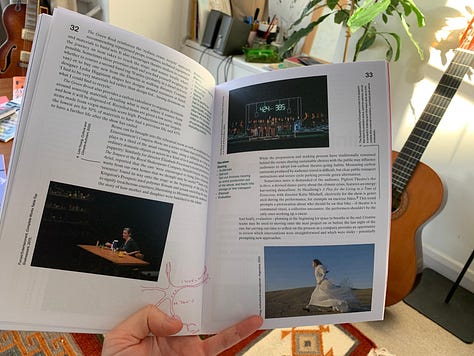
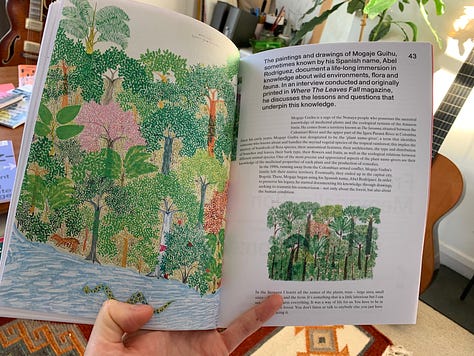
The special edition was an idea to try to make something a little quicker and simpler after a hiatus - obviously changing format is neither so it was ultimately more complex and time consuming. But it’s also another favourite: a mixture of projects and ideas that grapple with the climate crisis in different creative ways.
We curated the articles as a team, rather than solely from the editorial side, and the focus was reusing materials in innovative ways and using more photography than illustration. It was designed by our friends Open Practice, who ‘retrofit’ Matthew and Nina’s original creative concepts by mixing and matching templates and ideas from old issues and adding their own twists.
In this issue we had writers respond to old illustrations, and illustrators respond to old articles which I really enjoyed - we sent one of these writers her image to probe if she’d be interested and on seeing it she wrote a story straight away and sent it back before we’d even agreed terms or discussed it. In one article we had QR codes (that linked to sound pieces) rather than illustrations. Myself and Nina did our first, hopefully of many, piece together about Alexandra Daisy Ginsberg’s algorithmic garden and Nina also wrote an ‘Art Editor’s Letter’ to open the edition. The back spread has a ‘think pink live green’ barbie hiding in it given the barbie furore at the time. Barbies are pure consumption and the messaging in that film was awful, fwiw.
The graphics here were icons and symbols sourced by Open Practice.
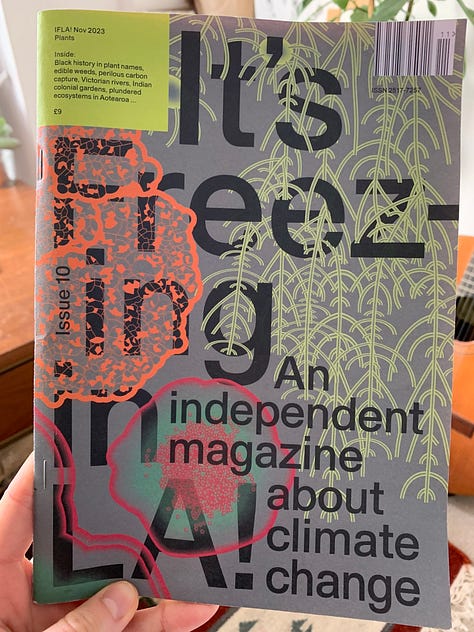
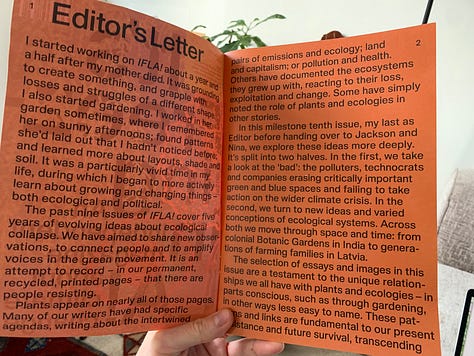
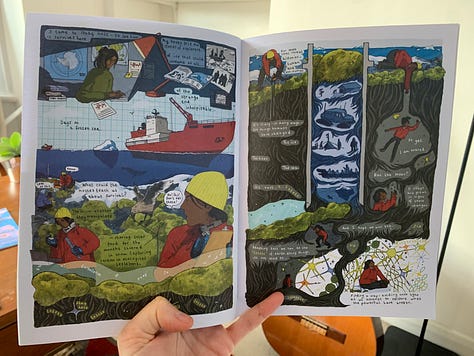
My final issue! We thought a lot about whether to splash out and do a shiny / big / long / super issue for the 10 milestone. But we decided that wasn’t very climate: we didn’t want to be thinking in the framework of endless growth and consumption mentality. So it’s more of the same, and hopefully that’s a good thing.
I wrote a more personal editor’s letter for this one. It’s about losing my mum (I didn’t go into the PhD debacle, substack fans only), and how building IFLA was about passing things on, community and learning from each other. It’s also about how plants can be this too, and how they are entangled in climate and our responses to climate. I think it’s maybe the piece of writing I’m most proud of, not that anyone reads editor’s letters. I worried a lot about publishing something so personal (even like this blog), but ultimately I suppose I wanted to make it clear that IFLA has always been, for me, dedicated to her.
Some highlights in this: Karthik Shankar’s brilliant mini essay on queerness and Indian botanic/colonial gardens, quietly one of the best things we’ve published in my opinion; Ojo Taiye’s poem about the ecology of Goi Creek, famous for being wrecked by oil companies; Holly O’Neil’s graphic novel imagining how climate scientists feel studying the changing world. I also love Hiren’s plant mix, to listen to as you read, at the back.
Matthew’s graphics here are drawings of lichens and fungi - a whole new world and not even plants!
Goodbye IFLA!, and good luck to the team with its next phase. I hope you do something wild with it! I admire and love you all very much.
My Thank Yous
Team, editorial team, editors, advice-givers and collaborators past and present:
Nina Carter, Jackson Howarth, Matthew Lewis, Grace Richardson Banks, Stephanie Glover, Hiren Parmar, Shaista Hussain, Sophie Compton, Alice Attlee, Anya Landolt, Open Practice.
Katie Urquhart, Grace Duncan, Lily Hosking, Eleanor Leydon, Harry Lloyd, Eleanor Warr, Alexander Harris, Alice Skinner, Jack Cribb, Christina Ivey, Leila Sackur, Elspeth Wilson.
Beatrice Liese, Joanna Lee, Robin Brinkworth, Seán Thór Herron, Gina Castellheim, Elana Sulakshana, Christiana Smyrilli, Pheobe Radford, Aranya Ram, Joseph Dillon, Seb Casalotti, Amira Damji, Rachel Angeli, Georgia Evans, Josh Marks, Riley Thorold, Kyle Turakhia, Aidan Chisholm, Joycelyn Longdon, Maryam Nahhal, Phoebe Thomson, Matt Hay, Lucy Wagstaffe, Helena Hosking, Arwa Nadeem, Sofia Palazzo-Corner, Jonny Lucas.
Jeremy Leslie, Steve Watson, Where the Leaves Fall, Contra Journal, Róisín Tapponi, Nikki Simpson, Lewis Beresford, Tim de Lisle, James Astell and the Sustainable Print, Ellie Wang and the San Mei Gallery, Rachel Angeli, Ashley Firth, Matt Booker, Patrick Dillon, Jo Moore, Housmans Books, Will Houghton, Cameron Beccario, Josh Flack, Aleksander Hamid, Jim Marschalek, Oliver Mettle, Rosy Schofield, Laura Coutinho, Helen Babbs and the Wellcome Collection, Andy Marsh and Central St Martins, Rebecca Lardeur and Climate + Cities, Tia Tasbihgou, Textile Exchange.
Writers:
Alice Attlee, Chris Barton, Andrew Clarke, Grace Duncan, Lily Hosking, Eleanor Leydon, Harry Lloyd, Joycelyn Longdon, Finlay Prescott, Kelsey Reichenbach, Grace Richardson Banks, Eleanor Warr, Shanar Tabrizi, Andrew Clarke, Suzanna Dhaliwal, Hayley Hardstaff, Matt Hay, Seán Thór Herron, Caroline Lucas, Ella Thorold, Jessica Tomlinson, Leslie Watson, Nicholas Canon, Robert Cobbold, Kitty Grady, Alexander Harris, Katie Kedward, Hannah Mac, Alice Skinner, Zoe Svendsen, Pheobe Thomson, Jake Thorold, James Woodall, Lola Young, Diego Arguedas Ortiz, Pierluigi Bizzini, Keira Dignan, James Morrison, Lucy Sherriff, Jocelyn Timperley, Veera Vehmas, Nicholas Barratt, Aaron Bradshaw, Rachel Dobbs, Vandana K, Adrienne Katz Kennedy, Miroslava Kojadinović, Zainab Mahmood, Billie Manning, Rhea Nandy, Aron Penczu, Carolina Salazar, Alice Bucknell, Charlotte Grubb, Christina Ivey, Ibrahim Kombarji, Christine Ochefu, Kyle Turakhia, Marco de Vidi, Sophie Yeo, Adrienne Buller, Amardeep Dhillon, Arielle Domb, Natalya Falconer, Josh Fenton, Kitty Horlick, Molly Lipson, Farai Mabeza, Jared Spears, Phobe Thomson, Ellen Grace, Jakob Hoffman, Andrew Key, Lakshmi Mitra, Vicky Mochama, Sudeshna Nag, Rudy Wickremasinghe Schulkind, Sahar Shah, Anna Souter, Ojo Taiye, Gail Tasker, Aja Barber, Alice Bell, Kayla Cohen, Abi Deivanayagam, Joe Duffy, Owen Hatherley, Imani Jaqueline Brown, Esther Kaner, Jean Ong, Rhiannon Osbourne, Tuğçe Özbiçer, Clayton Page Aldern, Dr Arianne Shahvisi, Elspeth Wilson, Samantha Cheh, Adrian Holme, Anoushka Khandwala, Daniel Milroy Maher, Lucy Zhang, Tina Alise Drupa, Annija Danenberga, Amirio Freeman, Georgina Johnson, Nicholas LePage, Gita Parihar, Hana Pera Aoake, Chris Saltmarsh, Karthik Shankar, Milly Shotter, Bouchra Tafrata, Giulia Trojano, George Walker.
Illustrators:
Charlotte Ager, Joey Yu, Matthew Armitage, Laurie Avon, Imi Black, Jade Delmage, Grace Dickinson, Matilda Ellis, Ruby Martin, Holly Mills, Sean O’Brien, Jiye Kim, Haeun Kim, Daise Rowe, Sienna Collins, Arad Golan Coll, Mary Herbert, Scott Kennedy, Sammi Lynch, Holly O’Neil, Zhu Ping, Giulia Corascello, Laina Deene, Josh Gabbatiss, Kitty Glavin, Lizzie Lomax, Theo Payne, Divya Scialo, Thomas White, Hannah Buckman, Leo MacDonald Oulds, Maggie Saunders, Rachel Wignall, Laylah Amarchih, Maxine Granzon, Zhongwen Hu, Charlotte Mei, Anna Skeels, Stefan Tiburcio, Holly Warburton, Alyina Zaidi, Jake Alexander, Laura Coutinho, Bobbye Fermie, Malena Guinet, Claire Harrup, Hua Jia, Bran Mackie, Danielle Rhoda, Ben Walker, Arjuna Gunarathne, Oliver MacDonald Oulds, Fungai Marima, Anthony Padilla, Liv Page, Fan Pu, Iwo Zaniewski, Misbah Ahmed, Ridha Andiantomanga, Vinna Begin, Rebecca Danning, Adriana Lozano, Amy Marici, Ciara Quilty-Harper, Catherine Ross, Sally Booth, Alberto Casias, Camille Deschiens, Ines Gradot, Jiye Kim, Jess Nash, Ifada Nisa, Shanti Panchal, Ines Viegas Oliveira, Byun Younggeun, Michelle Fung, Farida Eltigi, Aileen Harutunyan, Deming Huang, Serena Katt, Rachel Lillie, Shana Pagano Lohrey, Elisa Terranera, Arielle Walker, Sharpay Chenyue Yuan.


